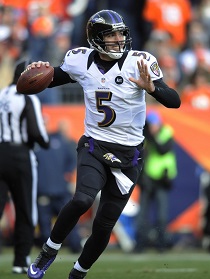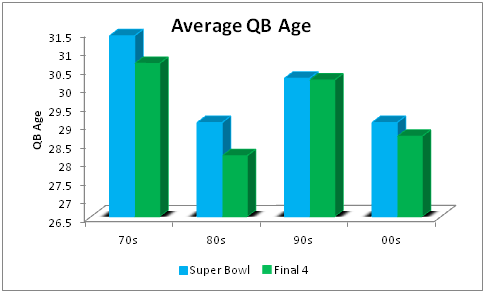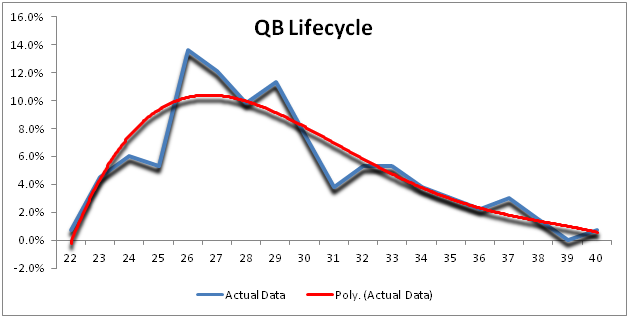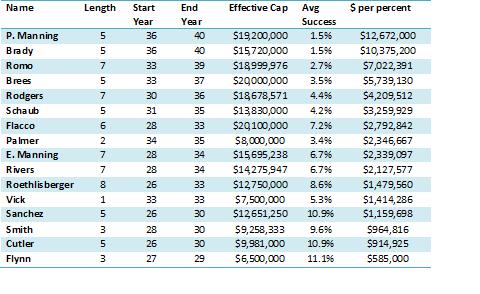[adsenseyu1]
With so many QB’s being extension possibilities over the next year I wanted to look at some of the things that maybe should be considered when weighing the option of extending a young player early or letting him play out his contract and dealing with him as he is ready to enter free agency.
The agent for Joe Flacco, Joe Linta, recently called the Baltimore Ravens “dumb” for not extending Flacco sooner. Flacco is likely going to be become the poster child for extending a contract early. According to Linta the Ravens had an offer on the table for about $16 million a year which they turned down and instead chose to roll the dice on Flacco continuing a rocky career with highs and lows that most likely would have seen his salary settle somewhere in the Jay Cutler region of like $13-14 million a season. Flacco’s financial future completely changed when the Denver Broncos inexplicably failed to defend almost the only type of play the Ravens could run in desperation time and the Ravens then advanced to the Super Bowl, where they held off a late charge by the 49’ers. Flacco, who has never had a 4,000 yard season, ended up earning over $20 million a season based on the Super Bowl win and now the Ravens have to hope that he makes the same turn that Eli Manning made following his first Super Bowl. Baltimore’s cap situation only complicated matters as they had no real possibility of franchising Flacco only to watch him sign a contract with the Cleveland Browns that their cap did not allow them to match. They gambled and lost.
But the situation can work both ways. The New York Jets decided to extend their young QB Mark Sanchez in 2012 to a 3 year extension worth $13.491 million a season. Sanchez was a higher pick than Flacco and, like Flacco, had some postseason success, going to two conference championship games in the first two seasons he played in the NFL. Statistically Sanchez was not a good QB, far worse than Flacco, but had a higher pedigree. The Jets thought process may have been a bit convoluted with Sanchez, as reports were that team officials felt the extension would motivate him to improve (plus the Jets needed salary cap relief), but in essence they gambled on extending the young QB early and getting what they felt were cap friendly terms over the long haul. The Jets seemed married to this idea that something magic happens with QB’s in year 4 because of Manning (trust me that was never going to be the case) and locked in an asset at a low cost. Sanchez’ contract isn’t a cap killer- his highest cap charge is $15.6 million in 2015 and there is minimal dead money to cut him in the future-, which is the benefit of the move, but he regressed so badly he is not worth 10 cents and the Jets cant cut him now because he is in that early guaranteed portion of the extension. If you flip the script and Sanchez wins a Super Bowl the Jets won big time because Sanchez would have earned $21 million a year heading into free agency. But he didn’t and the Jets look like fools. They gambled and lost.
Those are the two examples of the bad that the move can be, but there is plenty of good as well. The Packers took a bet on Aaron Rodgers at a pretty early point in time and locked up an MVP for under $13 million a season, which has driven the effective cost of his current contract down well below the stated $22 million figure. The Steelers extended their star QB, Ben Roethlisberger, early in his career to a deal that is worth under $15 million a year, an absolute bargain in the NFL, again with an effective value much lower than the extension amount. On the other side of the spectrum the Minnesota Vikings waited on Daunte Culpepper, who suffered a terrible injury, and he became the Dolphins contract headache. It works both ways.
There are a number of factors that have to go into the decision to extend early, a decision that is going to face many teams over the coming year. The biggest ones are Matthew Stafford, Matt Ryan, and Josh Freeman, three first round draft picks whose contracts are governed under the old NFL CBA, and Cam Newton, Andy Dalton, and Colin Kaepernick, all picks signed under the new CBA who will be eligible for extensions after the 2013 NFL season. Let’s look at the factors that a team should consider in making the decision:
1. Other Options
I’ll start with the non-financial aspects here. Remember when discussing a QB there are very limited options in free agency. Drew Brees is the one lone young star that really hit free agency and even that was off injury. Occasionally the older star becomes available such as Peyton Manning and Brett Favre. Teams have traded (and paid a hefty price for) Alex Smith, Carson Palmer, Jay Cutler, and Matt Cassel. As you look at the present day NFL the starters that will come from outside the organization at most will number 8. The names include Brees and Manning at the top followed by Schaub, Cutler, Vick, Palmer, Kolb, and Hoyer.
Most likely if the concern is inconsistency, which is going to be a factor for Freeman and Stafford and potentially Kaepernick who has no track record yet, it is not as if there will be a be a significantly better option in free agency. If you view yourself as a win now team will bringing in a Cutler, who will likely be the “hot” veteran in the 2014 offseason, bring you that much better of a chance? Probably not. Most likely your options are to start a low draft pick you made, trade for a teams “high upside” low draft pick (Kirk Cousins, Nick Foles, etc…) or pick up a garbage player who flopped with his original team (Sanchez, Blaine Gabbert, etc…). If these options do not appeal to you or are not going to exist by all means you should enter the negotiating room. The longer you wait the more apparent it becomes to an agent that you have no other options at the position.
2. Quality of Team
This goes hand in hand a little with the above category, but for two reasons. The first is what I would call the Sanchez syndrome and I would think could apply to Freeman this season as well as Dalton and perhaps Kaepernick depending on how things go now that teams have film to study. A QB is linked with a teams’ success and failures far beyond the true point of correlation. If you have a good football team that is capable of making a run to the playoffs it makes the QB more valuable that he statistically is. “All he does is win”. It sounds crazy, but it is what happens. If Flacco doesn’t win that Super Bowl he isn’t a 20 million dollar player. If Sanchez doesn’t get to the playoffs those two seasons he is not on the Jets. One or two games should not make a $5 million dollar difference but it does in the NFL. So if you have that quality team, you should know that the players’ value is most likely only going to go up by waiting. Atlanta, with a terrific shot at the Super Bowl, has almost zero to gain by waiting on Ryan.
The second reason is that the quality of your team often dictates what you can do year after year. We saw that list of free agents leading teams. It’s not exactly murders row. Brees was really the lone anomaly and he was a somewhat unique situation. Nobody else has won a championship nor come close. Favre had the one year with the Vikings and lost out to Brees. He was done the next year and the Vikings had to reset their team. The last QB to win prior to Brees that was not drafted by his team was Brad Johnson in 2002. The reality is a team should be prepared to go back into the draft and re-build rather than going into free agency/trade. Players agents should know this and know it leaves teams little options. If you as a GM are not ready to pull the plug on the team as constituted there is little benefit to waiting on a player who is capable of being a quality NFL QB. You just end up paying more for a player and make escaping that contract take more time in the event he doesn’t get better.
3. Market Movers
One of the most dangerous occurrences for a team in the NFL is the “market mover” contract. While many think the market is capped out with Rodgers making $22 million Im not sure. Rodgers took a contract that was significantly lower than I (and I think many others) projected. Part of it is doing business with the Packers and players may point to that when discussing options with other teams. There are a few names who worry me. One is Stafford. Stafford has never won a playoff game. He has only once had a winning record. He is inconsistent despite big numbers and throws to the best receiver in the NFL. His team is lousy and always playing catch up allowing for numbers to grow that are not meaningful.
But the Lions are one of the worst run front offices in the NFL, a team littered with insane cap charges, poor positional dollar allocations, huge dead money void years, and no cap space. One of the reasons is because of Stafford who is set to count for around $20 million in cap room each of the next two years. Quite frankly the Lions are going to get backed into a corner with him and that can lead to a tremendously overblown contract. Even if he fails to surpass Rodgers, just coming close opens the floodgates for Newton and especially Ryan. Roethlisberger and Manning both will be up for new deals soon and there is always a chance they jump Rodgers as well. Roethlisberger has cap advantages on his side to force the Steelers into a high priced deal while Manning plays in the big market and is a two time Super Bowl MVP. The Giants already made him the highest paid player once and I could see them doing it again. Every new deal pushes everyone below it. Teams have to be aware of the situations and how it could affect contracts.
4. Cap Constraints–
This really applied with Flacco in that the Ravens were completely hamstrung due to the salary cap when his contract was set to expire. The Ravens’ options with Flacco were to apply the Franchise tag or the Exclusive Franchise Tag. The regular tag is cheaper but allows the player to test free agency and you get the option of first refusal on a contract. The exclusive tag is more expensive but blocks movement. The issue here was that the Ravens cap was so tight that placing the exclusive tag on Flacco was unrealistic. They could not carry that salary cap number and function. They could carry him on the regular tag but were going to be capped out in the event a team signed him a frontloaded offer sheet. Teams like the Browns had so much cap room they could have afforded to take on a cap charge of $30 million in year 1 and $15 million in year 2 with no problems. The Ravens could never match that. Their cap forced them to sign him to a deal with low cap hits at the early end and deal with a leveraged restructure three years down the line. This is clearly an issue for the Lions and potentially, but to a far lesser extent than Flacco, for the Falcons. It could be an issue for the Panthers but they have other options which we will discuss in our next factor.
5. Cap Management
Of course in all of this the biggest factors often come down to salary cap. A team has multiple options with these players. For players drafted under the old CBA the franchise tag designations are a viable mechanism to protect their interest. For Kaepernick and Dalton the franchise tag is also an option. For Newton the Panthers hold a low cost option for the fifth season. Each scenario and player is different. For Stafford, due to his high cap charges the Lions need to consider a tag value and cap fee of $23.18 million to tag him. Ryan would be looking at a tag of $18.9 million on the exclusive tender assuming the Cowboys restructure the contract of Tony Romo. Freeman would probably be around $15 million as would Kaepernick and Dalton a year later. Newton’s one time tag value looks right now to be around $17.5 million.
Teams have to consider that tagging a player serves almost no purpose if you see a long term future with the player. Playing out the franchise tag means no proration. It means no accounting of guarantees. It’s really just a 1 year contract that is delaying the inevitable extension which will come the next year. Tagging the player does nothing but compromise your cap. It should only be used, IMO, on a veteran player on a win now team and has no business even being considered other than for negotiating tactics for a young player at this position, unless you just want one more try with the player rather than blowing it up by drafting a young talent.
When you lock a player up early one of the major benefits is the accounting benefits you get. Flacco’s deal is pure $20.1 million a year. In some way, shape, or form the Ravens need to account for $120.6 million over the next 6 seasons. He is really uncuttable until 2018 and in all likelihood will get another lucrative extension in 2016 just due to cap issues. Rodgers $22 million dollar deal is worth in real terms $18.68 million a year. That leads to a team having ways to manipulate the cap that benefit the team much moreso than the player.
While Rodgers will carry higher cap hits than Flacco the next three seasons the Packers are essentially insulated from cap issues on the backend because of their decision to extend early. Rodgers carries no dead money in 2018 and 2019 when he will be 35 and 36 years old. If his play nosedives they will survive without problem. In the event he plays great they could have a bargain since there is no early contract prorated money to account for in those seasons. Its pure pay for performance at that point.
Flacco’s last two seasons have dead money charges of $15.3 and $4.75 million. There is a lot sunk in the backend of his contract. He doenst have to perform to earn those backend salaries. Even if the Ravens restructure they are stuck with at least $10.55 million in prorated money in 2016 and 2017, meaning there is little for Baltimore to do to get anything resembling a low cap season out of Flacco at this point. Rodgers would only have $7 million in prorations with none at the end of the deal, simply because the Packers are able to manipulate the cap.
So organizationally if you are a team that sees future potential for big dollars needed to maintain free agents it is likely in the best interest of the team to extend early on. If you are a team that may be headed the young player route with the QB as the only ultra high priced talent you may be able to wait it out, but remember the longer you wait the more it impacts your ability to maintain high end players that make the turn off their rookie contracts.
Conclusions
While I used the QB as the prime example here I think many of these options also apply to other positions as well. While they may not compromise the cap as much they are integral part of the cap. Cap management cant be based on a philosophy of 53 individual contracts. Cap management must be based on a portfolio of 53 assets that complement each other so that a team can get the most team value and best on field performance for the money spent. What you do with Matt Stafford doesn’t just impact one player- it impacts what you can do with 52 other players.
So what would we do with our group? While normally I would put numeric grades down on a scale of 1-10 I think for this a quick qualitative chart will suffice. Freeman is the only player from the old CBA worth waiting on and I would let Dalton play his deal out too unless he did something miraculous this season. For the young guys they cant be extended until after the season so opinions will change though I think I have seen enough of Newton to say he is worth extending early barring injury.
| Player | Other Options | Team Quality | Market | Cap issues | Cap mgmt | Decision |
| Stafford | No | Poor | No | Yes | Yes | Extend |
| Ryan | No | Excellent | High | Mild | Yes | Extend |
| Freeman | Yes | Mid-tier | No | No | No | Wait |
| Kaepernick | No | Excellent | High | Mild | Yes | Extend |
| Newton | No | Mid-tier | High | Yes | Yes | Extend |
| Dalton | Some | Mid-tier | No | No | No | Wait |
[adsenseyu2]




